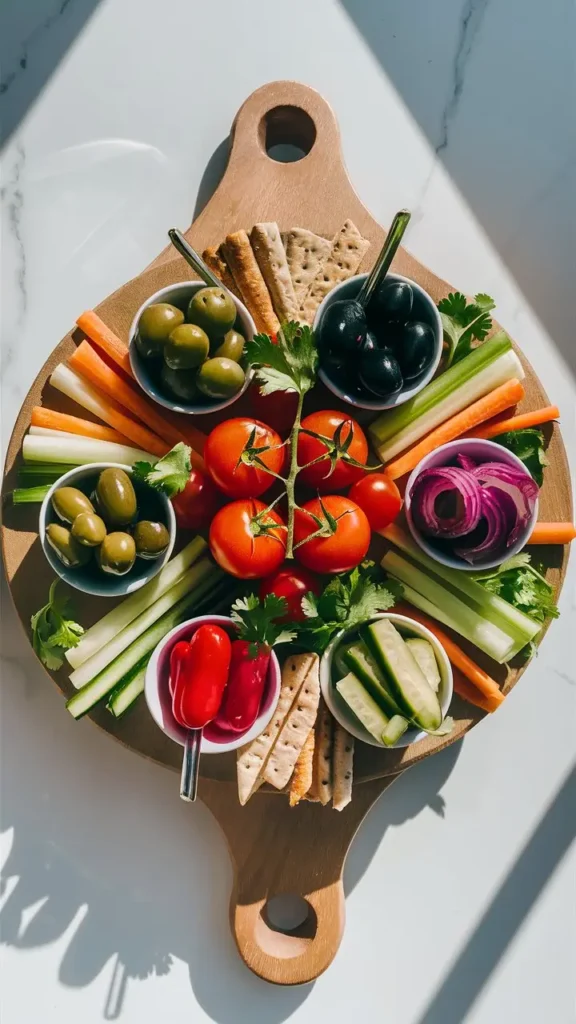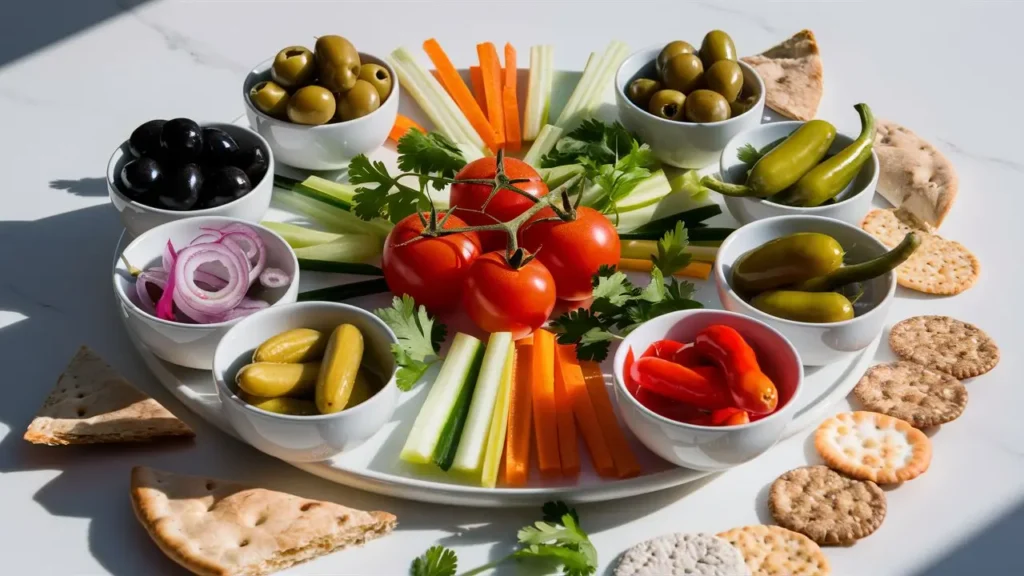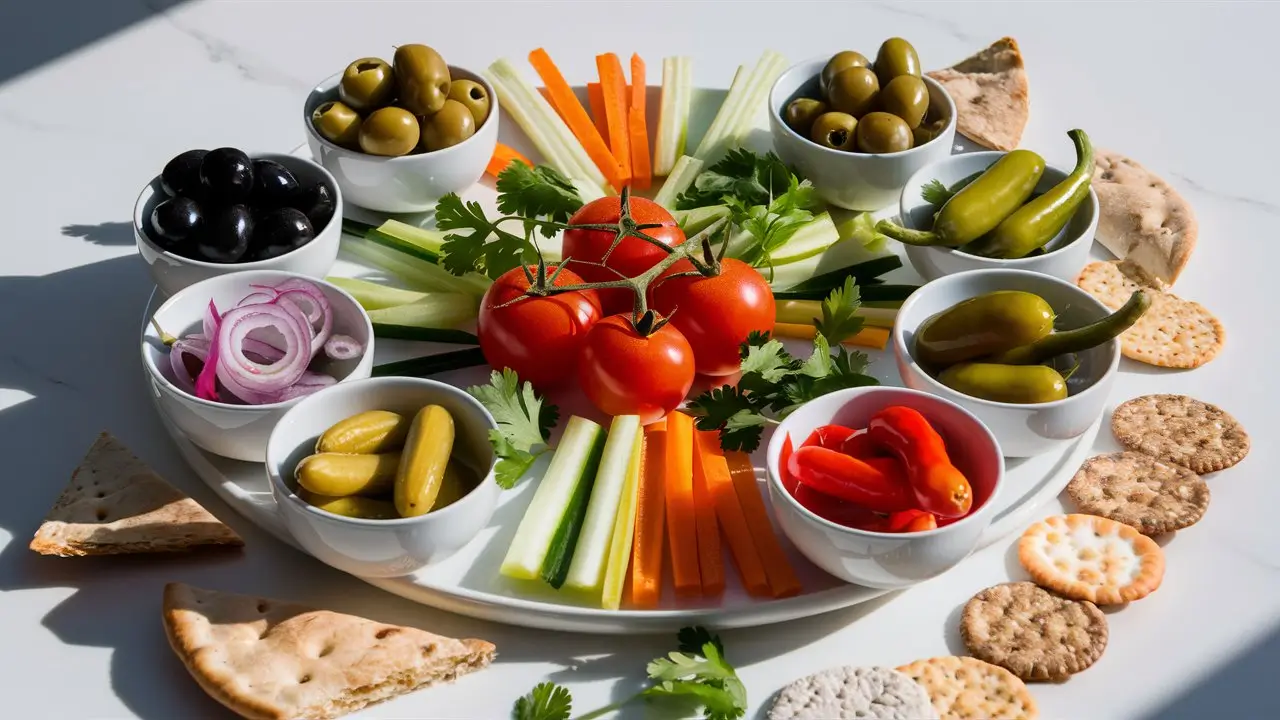A relish tray is a charming, old-school appetizer platter that deserves a permanent place at your table. It’s not only colorful and crisp but also incredibly easy to assemble and endlessly customizable. Whether you’re hosting a holiday dinner, a casual backyard barbecue, or a cocktail party, a well-prepared relish tray adds elegance, flavor, and nostalgia to the spread.
This guide covers everything you need to know—from choosing ingredients and styling your tray to serving tips and variations—to help you build a memorable and delicious relish tray every time.

Why You Will Love This Relish Tray
-
Effortless and No Cooking Required – It’s a stress-free, no-cook appetizer option.
-
Crisp, Tangy, and Refreshing – Perfect for cutting through rich or heavy dishes.
-
Customizable for All Occasions – Tailor it to match themes, dietary needs, or seasons.
-
Great for Make-Ahead – Can be prepped in advance for convenience.
What Is a Relish Tray?
A relish tray is a classic American appetizer platter featuring pickled and fresh vegetables, olives, and other savory bites. It dates back to early 20th-century dinner parties and remains popular for holidays like Thanksgiving and Christmas. Unlike a crudité platter, which focuses on raw vegetables with dips, a relish tray emphasizes tangy, briny, and often pickled items.
Ingredients List: What to Include on a Relish Tray
You can mix and match the following categories for a balanced and appealing assortment:
Pickled Items
-
Dill pickles (whole, spears, or chips)
-
Bread and butter pickles
-
Pickled beets
-
Pickled okra
-
Pickled green beans
-
Giardiniera (pickled vegetable mix)
Olives
-
Black olives (pitted or unpitted)
-
Green olives (stuffed with pimento, garlic, or blue cheese)
-
Kalamata olives
-
Castelvetrano olives
Fresh Vegetables
-
Celery sticks
-
Carrot sticks
-
Cucumber slices
-
Cherry tomatoes
-
Bell pepper strips
-
Radishes
Specialty Add-Ons (Optional)
-
Marinated mushrooms
-
Roasted red peppers
-
Pepperoncini
-
Pickled onions
-
Cheese cubes
-
Deviled eggs
-
Stuffed grape leaves
Timing & Servings
-
Prep Time: 20 minutes
-
Cook Time: 0 minutes
-
Total Time: 20 minutes
-
Servings: Serves 6–8 as an appetizer
Step-by-Step Instructions for Relish Tray
Step 1: Select a Tray or Platter
Choose a large serving platter, lazy Susan, cutting board, or divided relish dish. You can also use small bowls for juicy or strong-flavored items like olives or pickled onions.
Step 2: Arrange Items by Category
Group similar items together in clusters—pickles in one corner, olives in another, fresh veggies in the center. Use visual balance and alternate colors to create an appealing look.
Step 3: Use Small Bowls for Juicy Items
Contain messy or briny ingredients in ramekins or tiny bowls to avoid soggy veggies or flavor transfer.
Step 4: Garnish and Serve
Add sprigs of fresh herbs like dill, parsley, or thyme for color and aroma. Serve with cocktail forks or toothpicks for easy grabbing.

Tips for a Beautiful and Balanced Relish Tray
Mix Colors and Textures
Use vegetables and pickles of different colors, shapes, and textures for visual appeal and varied flavors.
Include Both Mild and Bold Options
Balance tangy pickles and salty olives with milder fresh veggies like cucumbers and carrots.
Keep Items Bite-Sized
Cut everything into easy-to-eat, grab-and-go pieces to make snacking effortless.
Use Dividers or Ramekins
Prevent flavors from blending and add organization by using small bowls or dividers.
The Best Occasions for Serving a Relish Tray
Holidays
-
Thanksgiving: A classic time to showcase a relish tray alongside turkey and stuffing.
-
Christmas: Add red and green veggies like cherry tomatoes and cucumber ribbons.
-
Easter: Pair with deviled eggs and pastel-colored pickled onions.
Parties and Potlucks
Relish trays are easy to assemble and travel well, making them ideal for gatherings, BBQs, and potlucks.
Cocktail Hours
The salty and briny elements pair wonderfully with martinis, whiskey sours, and other classic cocktails.
Relish Tray vs Crudités: What’s the Difference?
Feature Relish Tray Crudités Platter Focus Pickled and preserved items Fresh raw vegetables Dips Included? Not usually Often served with dips (ranch, hummus) Texture Tangy, crunchy, briny Crisp and fresh Popular Additions Olives, pickles, pepperoncini Carrots, celery, bell peppers
Both are great, but a relish tray is unique in its flavor and vintage charm.
Creative Relish Tray Variations
Mediterranean-Inspired
-
Add stuffed grape leaves, artichoke hearts, feta-stuffed olives, and roasted red peppers.
Southern-Style
-
Include pickled okra, chow-chow, boiled peanuts, and deviled eggs.
Charcuterie Combo
-
Add sliced meats like salami or prosciutto, along with cheese cubes and breadsticks.
Vegan Relish Tray
-
Stick to all plant-based items like pickled veggies, olives, and fresh produce without cheeses or eggs.
Make-Ahead and Storage Tips
Can You Make It Ahead of Time?
Yes! You can prep most of the items a day in advance and store them in airtight containers. Assemble the tray just before serving.
How to Store Leftovers
Store leftovers in separate containers to keep everything crisp and fresh. Leftover pickles and olives will last weeks in the fridge, while fresh veggies are best consumed within 2–3 days.
Pairing Your Relish Tray with Drinks and Dishes
Beverage Pairings
-
Cocktails: Bloody Mary, Martini, Manhattan, Negroni
-
Wine: Dry white wines like Sauvignon Blanc or sparkling wine
-
Beer: Pilsners and Belgian-style ales complement briny snacks
Food Pairings
-
Roasts, turkey, or ham dinners
-
Grilled meats or BBQ
-
Sandwiches or sliders
-
Cheese boards or charcuterie
Nutrition Overview (Per Serving Approximation)
Note: Will vary depending on items used
-
Calories: 80–120
-
Carbs: 5–10g
-
Fat: 4–8g (mostly from olives or add-ons)
-
Sodium: Moderate to high depending on pickles and olives
-
Fiber: 2–3g
-
Protein: 1–3g
This is a low-calorie, high-fiber, and nutrient-rich appetizer that fits into most dietary preferences.
FAQs
What’s the difference between a relish tray and an antipasto platter?
An antipasto platter often includes meats, cheeses, and marinated vegetables. A relish tray focuses more on pickled vegetables and olives with no meats.
Can I serve a relish tray with dips?
Yes. While not traditional, you can add dips like hummus or tzatziki for modern flair.
How long can a relish tray sit out?
Up to 2 hours at room temperature. If serving outdoors, consider placing the tray over a bowl of ice to keep items chilled.
What kind of platter works best?
Use any large, flat serving tray. You can even use a cutting board, divided dish, or lazy Susan.
Conclusion
A relish tray may seem retro, but its charm and flavor are timeless. It offers a refreshing, colorful contrast to rich foods and heavy meals, making it the perfect appetizer for nearly every occasion. It’s affordable, easy to make, and endlessly versatile.
Whether you stick to tradition with pickles and olives or add your creative twist with artisan items and seasonal produce, your relish tray will stand out as a thoughtful and inviting centerpiece on any table.
